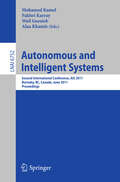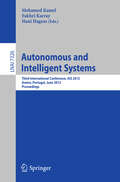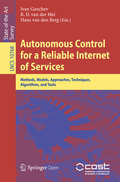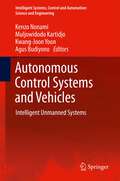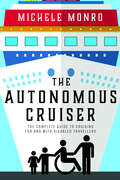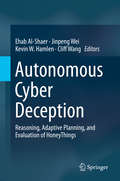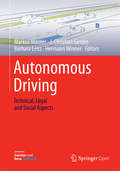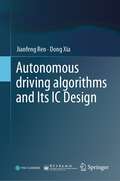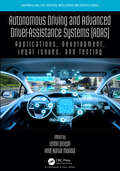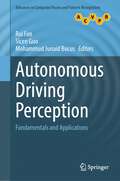- Table View
- List View
Autonomous and Intelligent Systems: Second International Conference, AIS 2011, Burnaby, BC, Canada, June 22-24, 2011, Proceedings (Lecture Notes in Computer Science #6752)
by Mohamed Kamel Fakhri Karray Wail Gueaieb Alaa KhamisThis book constitutes the refereed proceedings of the Second International Conference on Autonomous and Intelligent Systems, AIS 2011, held in Burnaby, BC, Canada, in June 2011, colocated with the International Conference on Image Analysis and Recognition, IACIAR 2011. The 40 revised full papers presented were carefully reviewed and selected from 62 submissions. The papers are organized in topical sections on autonomous and intelligent systems, intelligent and advanced control systems, intelligent sensing and data analysis, human-machine interaction, and intelligent circuit analysis and signal processing.
Autonomous and Intelligent Systems: Third International Conference, AIS 2012, Aviero, Portugal, June 25-27, 2012, Proceedings (Lecture Notes in Computer Science #7326)
by Mohamed Kamel Fakhri Karray Hani HagrasThis book constitutes the refereed proceedings of the Third International Conference on Autonomous and Intelligent Systems, AIS 2012, held in Aveiro, Portugal, in June 2012, collocated with the International Conference on Image Analysis and Recognition, IACIAR 2012. The 31 revised full papers were carefully reviewed and selected from 48 submissions. The papers are organized in topical sections on autonomous sensors and sensor systems, autonomous systems and intelligent control with applications, intelligent fuzzy systems, intelligent robotics, intelligent knowledge management, swarm and evolutionary methods, and applications
Autonomous Assembly: Designing for a New Era of Collective Construction (Architectural Design)
by Skylar TibbitsWe are now on the brink of a new era in construction – that of autonomous assembly. For some time, the widespread adoption of robotic and digital fabrication technologies has made it possible for architects and academic researchers to design non-standard, highly customised structures. These technologies have largely been limited by scalability, focusing mainly on top-down, bespoke fabrication projects, such as experimental pavilions and structures. Autonomous assembly and bottom-up construction techniques hold the promise of greater scalability, adaptability and potentially evolved design possibilities. By capitalising on the advances made in swarm robotics, the collective construction of the animal/insect kingdom, and advances in physical computational, programmable materials or self-assembly, architects and designers are now able to build from the bottom up. This issue presents future scenarios of autonomous assembly by highlighting the viability of decentralised, collective assembly systems, demonstrating the potential to deliver reconfigurable and adaptive solutions. Contributors include: Marcelo Coelho, Andong Liu, Robin Meier, Kieran Murphy and Heinrich Jaeger, Radhika Nagpal and Kirstin Petersen, and Zorana Zeravcic. Featured architects: Aranda\Lasch, Arup, Philippe Block, Gramazio Kohler Architects, Ibañez Kim, Achim Menges, Caitlin Mueller, Jose Sanchez, Athina Papadopoulou and Jared Laucks, and Skylar Tibbits.
The Autonomous Child: Theorizing Socialization (SpringerBriefs in Well-Being and Quality of Life Research)
by Ivar FrønesThe social sciences offer a variety of theories on how children develop, and various theories and disciplines apply their own vocabularies and conceptualise different aspects of the processes of socialization. This book looks at the theorizing of socialization in sociology, anthropology, psychology, in the life course approach, and as the interplay of genetics and environmental factors. It analyses the dominant perspectives and viewpoints within each discipline and field, and shows how the various theories and disciplines apply their own vocabularies and conceptualise different aspects of the processes of socialization. It argues that socialization does not represent a fixed trajectory into a static social order, and that different disciplines meet the challenges of complex developmental processes and changing environments in different ways. Socialization is a fundamental concept in sociology, but sociology has only to a limited degree sought to produce a coherent understanding of the processes of socialization, which has to encompass the interplay of societal, psychological and genetic factors. This book draws the threads together and, by doing so, offers a general framework for our understanding of the socialization process. At the centre of this process is the child as a subject, in an interplay with the patterns and significant others of the micro environment as well as with the macro-conditions of the modern knowledge based economies.
The Autonomous Child: Day Care and the Transmission of Values (Routledge Revivals)
by Carol Speekman KlassOriginally published in 1986, this book’s focal point is a field study which asks whether the social childrearing context of daycare transmits to young children values different from those within America’s dominant value tradition of individualism. Daycare critics were concerned that this social childrearing within daycare would weaken the family and promote collectivist rather than individualistic values, and thereby threaten the social continuity of America’s values. Through participant observation four daycare teachers’ interactions as they emphasize children’s individual learning experiences and children’s social learning experiences are examined. By focusing on the actions and words of daycare teachers and their children in their daily activities over time, this field study provides a conceptual model for an initial understanding of the relationship of daycare to the continuity of America’s values.
The Autonomous Child: Day Care and the Transmission of Values (Routledge Revivals)
by Carol Speekman KlassOriginally published in 1986, this book’s focal point is a field study which asks whether the social childrearing context of daycare transmits to young children values different from those within America’s dominant value tradition of individualism. Daycare critics were concerned that this social childrearing within daycare would weaken the family and promote collectivist rather than individualistic values, and thereby threaten the social continuity of America’s values. Through participant observation four daycare teachers’ interactions as they emphasize children’s individual learning experiences and children’s social learning experiences are examined. By focusing on the actions and words of daycare teachers and their children in their daily activities over time, this field study provides a conceptual model for an initial understanding of the relationship of daycare to the continuity of America’s values.
Autonomous Consumer Business
by Julian MorgenEine immer mehr digital vernetzte Welt führt zu einer sehr großen Menge von unterschiedlichen Daten, die in Echtzeit generiert werden („Big Data“). Ein großer Teil dieser Datenproduzenten sind Nutzer von Social Media oder auch smarten Geräten, wie bspw. Fitnesstrackern oder mit dem Internet verbundenen Waschmaschinen („IoT“). Unternehmen, die sich diese Daten aus der direkten Lebenswelt der Konsumenten zu Nutze machen, können sehr präzise Einblicke bspw. über Einstellungen, Verhalten oder auch die Bedürfnisse potenzieller Kunden erhalten, wodurch der Weg zu einer „automatisierten Vermarktung“ geebnet wird. Zielsetzung dieses Buches ist die Entwicklung eines Konzeptes für ein Autonomous Consumer Business (ACB), das als maximal eigenständig agierendes und durch Künstliche Intelligenz getragenes Geschäftsmodell verstanden wird, bei dem Unternehmen die Bedürfnisse auf der Konsumentenseite automatisch erkennen und durch entsprechende Leistungsangebote befriedigen können. Weiterhin werden zentrale Bestimmungsgrößen, welche die konsumentenseitige Inanspruchnahme eines ACB im besonderen Maße beeinflussen, sowie potenzielle Kundengruppen empirisch identifiziert, wodurch Hinweise zur konkreten Ausgestaltung eines ACB gewonnen werden können.
Autonomous Control for a Reliable Internet of Services: Methods, Models, Approaches, Techniques, Algorithms, and Tools (Lecture Notes in Computer Science #10768)
by Ivan Ganchev R. D. van der Mei Hans van den BergThis open access book was prepared as a Final Publication of the COST Action IC1304 “Autonomous Control for a Reliable Internet of Services (ACROSS)”. The book contains 14 chapters and constitutes a show-case of the main outcome of the Action in line with its scientific goals. It will serve as a valuable reference for undergraduate and post-graduate students, educators, faculty members, researchers, engineers, and research strategists working in this field. The explosive growth of the Internet has fundamentally changed the global society. The emergence of concepts like SOA, SaaS, PaaS, IaaS, NaaS, and Cloud Computing in general has catalyzed the migration from the information-oriented Internet into an Internet of Services (IoS). This has opened up virtually unbounded possibilities for the creation of new and innovative services that facilitate business processes and improve the quality of life. However, this also calls for new approaches to ensuring the quality and reliability of these services. The objective of this book is, by applying a systematic approach, to assess the state-of-the-art and consolidate the main research results achieved in this area.
Autonomous Control Systems and Vehicles: Intelligent Unmanned Systems (Intelligent Systems, Control and Automation: Science and Engineering #65)
by Kenzo Nonami, Muljowidodo Kartidjo, Kwang-Joon Yoon and Agus BudiyonoThe International Conference on Intelligent Unmanned Systems 2011 was organized by the International Society of Intelligent Unmanned Systems and locally by the Center for Bio-Micro Robotics Research at Chiba University, Japan. The event was the 7th conference continuing from previous conferences held in Seoul, Korea (2005, 2006), Bali, Indonesia (2007), Nanjing, China (2008), Jeju, Korea (2009), and Bali, Indonesia (2010). ICIUS 2011 focused on both theory and application, primarily covering the topics of robotics, autonomous vehicles, intelligent unmanned technologies, and biomimetics. We invited seven keynote speakers who dealt with related state-of-the-art technologies including unmanned aerial vehicles (UAVs) and micro air vehicles (MAVs), flapping wings (FWs), unmanned ground vehicles (UGVs), underwater vehicles (UVs), bio-inspired robotics, advanced control, and intelligent systems, among others. This book is a collection of excellent papers that were updated after presentation at ICIUS2011. All papers that form the chapters of this book were reviewed and revised from the perspective of advanced relevant technologies in the field. The aim of this book is to stimulate interactions among researchers active in the areas pertinent to intelligent unmanned systems.
Autonomous Cooperation and Control in Logistics: Contributions and Limitations - Theoretical and Practical Perspectives
by Michael Hülsmann, Bernd Scholz-Reiter and Katja WindtMany new technologies – like RFID, GPS, and sensor networks – that dominate innovative developments in logistics are based on the idea of autonomous cooperation and control. This self-organisational concept describes „...processes of decentralized decision-making in heterarchical structures. It presumes interacting elements in non-deterministic systems, which possess the capability and possibility to render decisions. The objective of autonomous cooperation and control is the achievement of increased robustness and positive emergence of the total system due to distributed and flexible coping with dynamics and complexity“ (Hülsmann & Windt, 2007). In order to underlie these technology-driven developments with a fundamental theoretical foundation this edited volume asks for contributions and limitations of applying the principles of autonomous cooperation and control to logistics processes and systems. It intends to identify, describe, and explain – in the context of production and distribution logistics – the effects on performance and robustness, the enablers and impediments for the feasibility, the essential cause-effect-relations, etc. of concepts, methods, technologies, and routines of autonomous cooperation and control in logistics. Therefore, the analyses collected in this edited volume aim to develop a framework for finding the optimal degree as well as the upper and lower boundaries of autonomous cooperation and control of logistics processes from the different perspectives of production technology, electronics and communication engineering, informatics and mathematics, as well as management sciences and economics.
The Autonomous Cruiser
by Michele MonroWith the expansion of the cruising sector, it is difficult to keep up as the goalposts keep changing, but one thing hasn't changed: the travel industry's inability to provide a disabled traveller with what they need to plan a stress-free adventure.Information on accessibility can be hard to find and the internet is filled with dead and out-of-date sites. Being disabled can be hard enough but I believe information is power, the power to be able to control our choices and know what we are going to come up against when we pick a cruise.This general how-to on cruising is the first of its kind, aimed at giving you the power to make your own choices, take control and organise the perfect seafaring holiday, getting the best out of both the ship and its destinations.Bon Voyage
Autonomous Cyber Deception: Reasoning, Adaptive Planning, and Evaluation of HoneyThings
by Cliff Wang Ehab Al-Shaer Jinpeng Wei Kevin W. HamlenThis textbook surveys the knowledge base in automated and resilient cyber deception. It features four major parts: cyber deception reasoning frameworks, dynamic decision-making for cyber deception, network-based deception, and malware deception. An important distinguishing characteristic of this book is its inclusion of student exercises at the end of each chapter. Exercises include technical problems, short-answer discussion questions, or hands-on lab exercises, organized at a range of difficulties from easy to advanced,. This is a useful textbook for a wide range of classes and degree levels within the security arena and other related topics. It’s also suitable for researchers and practitioners with a variety of cyber security backgrounds from novice to experienced.
Autonomous Data Security: Creating a Proactive Enterprise Protection Plan
by Priyanka NeelakrishnanThis book focuses on analyzing the foundational requirements necessary to construct an autonomous data protection solution for enterprise businesses. It navigates readers through various options and tools, outlining the advantages and disadvantages of each. Covering diverse deployment environments including cloud, on-premises, and hybrid setups, as well as different deployment scales and comprehensive channel coverages, it encourages readers to break away from conventional norms in their approach. By exploring the factors that should be taken into account, the book highlights the significant gap in existing data safeguarding solutions, which often rely solely on configured security policies. It proposes a forward-thinking security approach designed to endure over time, surpassing traditional policies and urging readers to consider proactive autonomous data security solutions. Additionally, it delves into the system's ability to adapt to deployed environments, learn from feedback, and autonomously safeguard data while adhering to security policies. More than just a set of guidelines, this book serves as a catalyst for the future of the cybersecurity industry. Its focus on autonomous data security and its relevance in the era of advancing AI make it particularly timely and essential. What You Will learn: Understand why data security is important for enterprise businesses. How data protection solutions work and how to evaluate a solution in the market. How to start thinking and evaluating requirements when building a solution for small, medium, and large enterprises. Understand the pros and cons of security policy configurations defined by administrators and why can’t they provide comprehensive protection. How to safeguard data via adaptive learning from the deployed environment – providing autonomous data security with or without policies. How to leverage AI to provide data security with comprehensive proactive protection. What factors to consider when they have to protect and safeguard data. Who this book is for: The primary audience is cybersecurity professionals, security enthusiasts, C-level executives in organizations (all verticals), and security analysts and IT administrators. Secondary audience includes professors and teachers, channel integrators, professional services, and hackers.
Autonomous Driving: How the Driverless Revolution will Change the World
by Andreas Herrmann Walter Brenner Rupert StadlerThis book looks at the latest advances in autonomous driving, demonstrating that a future once considered science fiction is now close at hand. Acceptance of driverless cars relies on more than just the technology that delivers it; in this book the authors consider the shift in attitudes required for social acceptance and a move towards considering cars one aspect of a wider mobility solution. In addition, a clear demand is arising from gridlocked megacities across the globe. Autonomous driving offers a solution for the high pollution levels and management of the transport infrastructure where current methods are proving insufficient in places of high population density. Having highlighted the need for driverless cars, the book concludes with an ambitious agenda to ensure the successful delivery of autonomous driving. Political requirements, including investment in a new infrastructure and a commitment to collaboration across borders factors in the ten-point plan for governments seeking to establish international leaders in the latest advances in mobility services. From ethical considerations in the programming of automated driving procedures to changes in attitudes towards car ownership and design, this title is a comprehensive look at the latest revolution in mobility.
Autonomous Driving: How the Driverless Revolution will Change the World (Economics In The Real World Ser.)
by Andreas Herrmann Walter Brenner Rupert StadlerThis book looks at the latest advances in autonomous driving, demonstrating that a future once considered science fiction is now close at hand. Acceptance of driverless cars relies on more than just the technology that delivers it; in this book the authors consider the shift in attitudes required for social acceptance and a move towards considering cars one aspect of a wider mobility solution. In addition, a clear demand is arising from gridlocked megacities across the globe. Autonomous driving offers a solution for the high pollution levels and management of the transport infrastructure where current methods are proving insufficient in places of high population density. Having highlighted the need for driverless cars, the book concludes with an ambitious agenda to ensure the successful delivery of autonomous driving. Political requirements, including investment in a new infrastructure and a commitment to collaboration across borders factors in the ten-point plan for governments seeking to establish international leaders in the latest advances in mobility services. From ethical considerations in the programming of automated driving procedures to changes in attitudes towards car ownership and design, this title is a comprehensive look at the latest revolution in mobility.
Autonomous Driving: Technical, Legal and Social Aspects
by Markus Maurer J. Christian Gerdes Barbara Lenz Hermann WinnerThis book takes a look at fully automated, autonomous vehicles and discusses many open questions: How can autonomous vehicles be integrated into the current transportation system with diverse users and human drivers? Where do automated vehicles fall under current legal frameworks? What risks are associated with automation and how will society respond to these risks? How will the marketplace react to automated vehicles and what changes may be necessary for companies?Experts from Germany and the United States define key societal, engineering, and mobility issues related to the automation of vehicles. They discuss the decisions programmers of automated vehicles must make to enable vehicles to perceive their environment, interact with other road users, and choose actions that may have ethical consequences. The authors further identify expectations and concerns that will form the basis for individual and societal acceptance of autonomous driving. While the safety benefits of such vehicles are tremendous, the authors demonstrate that these benefits will only be achieved if vehicles have an appropriate safety concept at the heart of their design. Realizing the potential of automated vehicles to reorganize traffic and transform mobility of people and goods requires similar care in the design of vehicles and networks. By covering all of these topics, the book aims to provide a current, comprehensive, and scientifically sound treatment of the emerging field of “autonomous driving".
Autonomous driving algorithms and Its IC Design
by Jianfeng Ren Dong XiaWith the rapid development of artificial intelligence and the emergence of various new sensors, autonomous driving has grown in popularity in recent years. The implementation of autonomous driving requires new sources of sensory data, such as cameras, radars, and lidars, and the algorithm processing requires a high degree of parallel computing. In this regard, traditional CPUs have insufficient computing power, while DSPs are good at image processing but lack sufficient performance for deep learning. Although GPUs are good at training, they are too “power-hungry,” which can affect vehicle performance. Therefore, this book looks to the future, arguing that custom ASICs are bound to become mainstream. With the goal of ICs design for autonomous driving, this book discusses the theory and engineering practice of designing future-oriented autonomous driving SoC chips.The content is divided into thirteen chapters, the first chapter mainly introduces readers to the current challenges and research directions in autonomous driving. Chapters 2–6 focus on algorithm design for perception and planning control. Chapters 7–10 address the optimization of deep learning models and the design of deep learning chips, while Chapters 11-12 cover automatic driving software architecture design. Chapter 13 discusses the 5G application on autonomous drving. This book is suitable for all undergraduates, graduate students, and engineering technicians who are interested in autonomous driving.
Autonomous Driving and Advanced Driver-Assistance Systems: Applications, Development, Legal Issues, and Testing (Chapman & Hall/CRC Artificial Intelligence and Robotics Series)
by Lentin JosephAutonomous Driving and Advanced Driver-Assistance Systems (ADAS): Applications, Development, Legal Issues, and Testing outlines the latest research related to autonomous cars and advanced driver-assistance systems, including the development, testing, and verification for real-time situations of sensor fusion, sensor placement, control algorithms, and computer vision. Features: Co-edited by an experienced roboticist and author and an experienced academic Addresses the legal aspect of autonomous driving and ADAS Presents the application of ADAS in autonomous vehicle parking systems With an infinite number of real-time possibilities that need to be addressed, the methods and the examples included in this book are a valuable source of information for academic and industrial researchers, automotive companies, and suppliers.
Autonomous Driving and Advanced Driver-Assistance Systems: Applications, Development, Legal Issues, and Testing (Chapman & Hall/CRC Artificial Intelligence and Robotics Series)
by Lentin Joseph Amit Kumar MondalAutonomous Driving and Advanced Driver-Assistance Systems (ADAS): Applications, Development, Legal Issues, and Testing outlines the latest research related to autonomous cars and advanced driver-assistance systems, including the development, testing, and verification for real-time situations of sensor fusion, sensor placement, control algorithms, and computer vision. Features: Co-edited by an experienced roboticist and author and an experienced academic Addresses the legal aspect of autonomous driving and ADAS Presents the application of ADAS in autonomous vehicle parking systems With an infinite number of real-time possibilities that need to be addressed, the methods and the examples included in this book are a valuable source of information for academic and industrial researchers, automotive companies, and suppliers.
Autonomous Driving Changes the Future
by Zhanxiang Chai Tianxin Nie Jan BeckerThis book systematically discusses the development of autonomous driving, describing the related history, technological advances, infrastructure, social impacts, international competition, China’s opportunities and challenges, and possible future scenarios. This popular science book uses straightforward language and includes quotes from ancient Chinese poems to enhance the reading experience. The discussions are supplemented by theoretical elaborations, presented in tables and figures.The book is intended for auto fans, upper undergraduate and graduate students in the field of automotive engineering.
Autonomous Driving Network: Network Architecture in the Era of Autonomy
by Wenshuan Dang River Huang Yijun Yu Yong ZhangAiming to outline the vision of realizing automated and intelligent communication networks in the era of intelligence, this book describes the development history, application scenarios, theories, architectures, and key technologies of Huawei's Autonomous Driving Network (ADN) solution. In the book, the authors explain the design of the top-level architecture, hierarchical architecture (ANE, NetGraph, and AI Native NE), and key feature architecture (distributed AI and endogenous security) that underpin Huawei's ADN solution. The book delves into various key technologies, including trustworthy AI, distributed AI, digital twin, network simulation, digitization of knowledge and expertise, human-machine symbiosis, NE endogenous intelligence, and endogenous security. It also provides an overview of the standards and level evaluation methods defined by industry and standards organizations, and uses Huawei's ADN solution as an example to illustrate how to implement AN. This book is an essential reference for professionals and researchers who want to gain a deeper understanding of automated and intelligent communication networks and their applications.
Autonomous Driving Network: Network Architecture in the Era of Autonomy
by Wenshuan Dang River Huang Yijun Yu Yong ZhangAiming to outline the vision of realizing automated and intelligent communication networks in the era of intelligence, this book describes the development history, application scenarios, theories, architectures, and key technologies of Huawei's Autonomous Driving Network (ADN) solution. In the book, the authors explain the design of the top-level architecture, hierarchical architecture (ANE, NetGraph, and AI Native NE), and key feature architecture (distributed AI and endogenous security) that underpin Huawei's ADN solution. The book delves into various key technologies, including trustworthy AI, distributed AI, digital twin, network simulation, digitization of knowledge and expertise, human-machine symbiosis, NE endogenous intelligence, and endogenous security. It also provides an overview of the standards and level evaluation methods defined by industry and standards organizations, and uses Huawei's ADN solution as an example to illustrate how to implement AN. This book is an essential reference for professionals and researchers who want to gain a deeper understanding of automated and intelligent communication networks and their applications.
Autonomous Driving Perception: Fundamentals and Applications (Advances in Computer Vision and Pattern Recognition)
by Rui Fan Sicen Guo Mohammud Junaid BocusDiscover the captivating world of computer vision and deep learning for autonomous driving with our comprehensive and in-depth guide. Immerse yourself in an in-depth exploration of cutting-edge topics, carefully crafted to engage tertiary students and ignite the curiosity of researchers and professionals in the field. From fundamental principles to practical applications, this comprehensive guide offers a gentle introduction, expert evaluations of state-of-the-art methods, and inspiring research directions. With a broad range of topics covered, it is also an invaluable resource for university programs offering computer vision and deep learning courses. This book provides clear and simplified algorithm descriptions, making it easy for beginners to understand the complex concepts. We also include carefully selected problems and examples to help reinforce your learning. Don't miss out on this essential guide to computer vision and deep learning for autonomous driving.
Autonomous Dynamic Reconfiguration in Multi-Agent Systems: Improving the Quality and Efficiency of Collaborative Problem Solving (Lecture Notes in Computer Science #2427)
by Markus HannebauerHigh communication efforts and poor problem solving results due to restricted overview are two central issues in collaborative problem solving. This work addresses these issues by introducing the processes of agent melting and agent splitting that enable individual problem solving agents to continually and autonomously reconfigure and adapt themselves to the particular problem to be solved. The author provides a sound theoretical foundation of collaborative problem solving itself and introduces various new design concepts and techniques to improve its quality and efficiency, such as the multi-phase agreement finding protocol for external problem solving, the composable belief-desire-intention agent architecture, and the distribution-aware constraint specification architecture for internal problem solving. The practical relevance and applicability of the concepts and techniques provided are demonstrated by using medical appointment scheduling as a case study.
